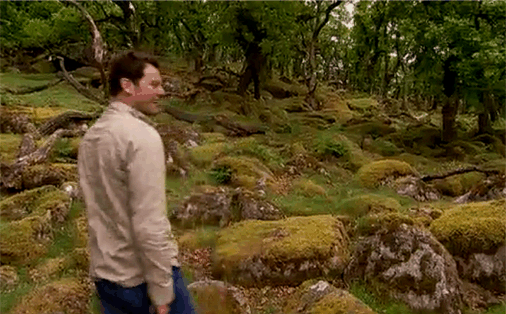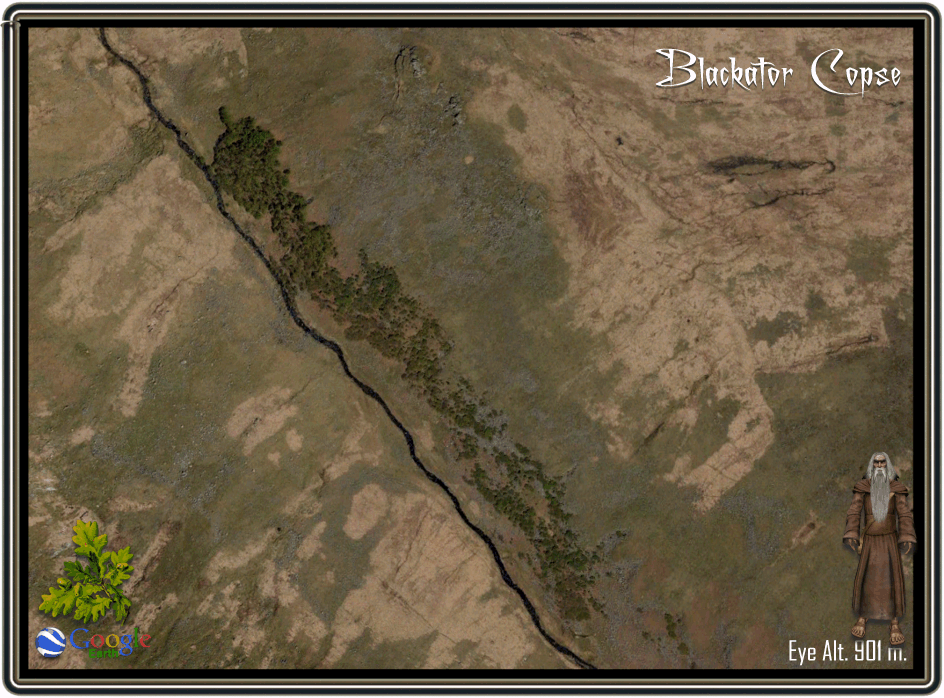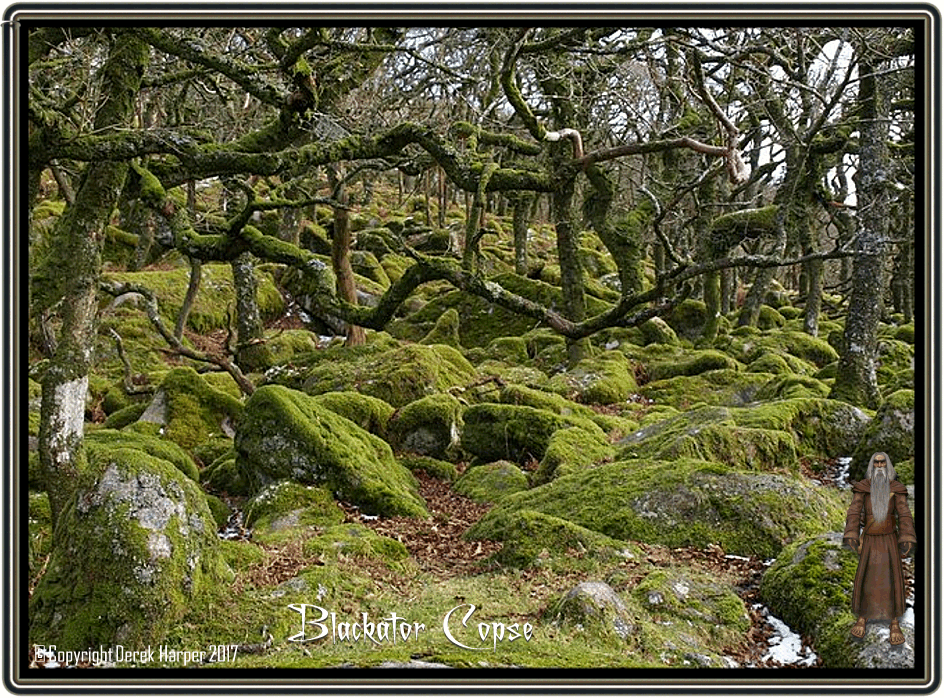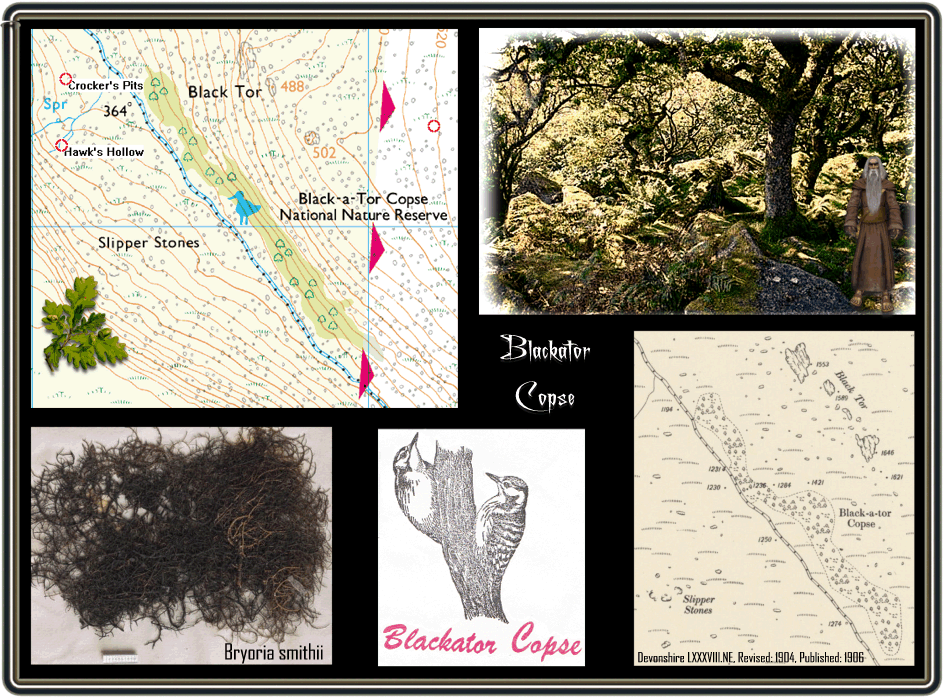
“Black Tor Copse (Blackator Copse) spreads straggling under the granite masses above. It is a stony grove set in a wilderness, flanked by the steep of a mountain on one side, fringed by the silver of Oke (West Okement) upon the other. The song of this river met the lisp of the leaves in ceaseless strophe and antistrophe through summer months. Now the wind woke the foliage and diminished the voice of the water ; now the tinkle and whisper of glittering falls dominated any listening ear with their music. Sometimes the trees slept and not a leaf stirred ; sometimes their arboreal slumbers would suddenly be broken by a mighty clatter, when blue-winged wood-doves clashed away from hiding-places under the low boughs. Or at twilight a fox might bark and break the primal peace of this most ancient wood. These and countless lesser things knew the place for home ; but conscious creatures rarely haunted it.” Eden Phillpotts, The Portreeve, p.242.
Originally known as Black Tor Beare this is the third example of an ancient high altitude woodland to be found on Dartmoor, the other two being Wistman’s Wood and Piles Copse. Although the word ‘Beare‘ has now been discarded and replaced by the word ‘Copse’ it originally derived from the Anglo Saxon word ‘bearu‘ denoting a grove or wood. William Crossing informs us that; “Documentary evidence exists showing that this wood was once very much more extensive than at present; it probably stretched from the Island of Rocks into the forest. There is mention of it by the jurors of the 1609 survey, (Dartmoor Perambulation) and also in the Lydford Court Rolls of the time of Elizabeth (the first).” 1990, p.196. As to the age of the copse there is very little early documentation and what there is comes from the late 1500s into the 1600s. During the September of 1587 the jury of oaths presented to the manor and forest court at Lydford that one William Bowden had cut certain oaks in; “Blacktors Beare infra Forest pd,” for which he was fined threepence. In 1609 a presentment was made to the Court of Survey held at Okehampton which stated; “Item further also they do present that Willam Chastie (by his own confessyon) kild a stagge with a pece or gun nere a month since about Blacktorrebeare and that he did it for Sir Thomas Wys (which is part in the forest of Dartmoor and part in venvill) and that he did it for Sir Thomas Wys (Wise) and delivered the same to the said Sir Thomas at his house at Sidnham, at which tyme he told him that he had kild the same dere in the fforest.” In an undated document from the seventeenth century called the ‘Review of Woods’ in which there was mention of eight acres of underwood being cut at, “Black Tores Beare in the Forest of Dartmoor.” According to Worth this suggested that the eight acres would have been the total area of the copse in which case it was no larger then as when he wrote those words. This directly contradicted Crossing’s statement which said; “that this wood was once very much more extensive than at present.” Worth also considered that around 1618 – 20 was possibly when the copse was cut thus suggesting that in his time a few of the trees in the copse could escaped felling and have been some 300 years old. pp.86 -87. It’s interesting to see the various interpretations made about the above documents. With the presentment of 1609. Crossing took this to infer that Black-a-Tor Copse was infact situated within the bounds of The Forest of Dartmoor, a contradiction to popular theory. To further reinforce his idea the words from the ‘Review of Woods’ – ‘in the forest of Dartmoor’ he took to mean The Forest of Dartmoor as laid out in the perambulations 1987, p.43. Worth however was less sure about Crossing’s theory and pointed out that there was room for mis-interpretation in the word ‘Forest’. It could mean ‘The Forest of Dartmoor’ or possibly a forest on Dartmoor in which case Crossing was for once mistaken.
Black-a-Tor Copse sits at an altitude of 380 metres above sea level and covers some 29 acres. The wood is leased from the Duchy of Cornwall by Natural England but according to their website the nature reserve is not actually managed. They describe the copse as where; “English oak trees have grown through large granite boulders or ‘clitter’ to create a woodland which is nationally important for rare lichens and mosses. The clean air and damp humid conditions of Dartmoor provide the perfect place for the lichens to thrive. As well as rare lichens such as Bryoria smithii, more common species including the beard lichen can also be spotted. Twenty species of breeding birds have been recorded in the woodland and surrounding habitat, including ring ouzel and redstart.”
By far the dominant tree species growing in the copse is Quercus Robur commonly known as the English or Pedunculate, also present are the Sorbus aucuparia or Rowan trees along with a ground cover of Blechnum spicant – hard-fern, Hedera helix – ivy and Vaccinium myrtillus – whortleberries. The trees have a natural deformity of leaning between an easterly and westerly direction thanks to the effects of the Dartmoor winds which blast through the valley. In addition the climate has also led to the stunting of the tree growth leading to what’s normally described as ‘dwarf’ trees. Black-a-Tor Copse is said to be home for 44 different species of mosses and liverworts and over time 133 species have been recorded. The copse is reportedly the only major site in the British Isles where the lichen Bryoria smithii can be found. Another rare lichen which can be found growing on the rocks and boulders above the copse is Parmelia disscordans and is said the be the only site south of Scotland where it can be found. Should you be interested in the lichens growing in and around the copse then an Excel spreadsheet is available from Natural England. This contains a master list of all lichen records within the reserve drawing together data taken from all historical records from 1960 to 2013. Some twenty species of breeding birds have been recorded in the woodland and surrounding habitat and it is said to be the best location on Dartmoor to see the elusive Ring Ouzel.
Sadly there has been some concern as to the well being of the copse in recent years. One of the major problems was the lack of young seedling and saplings growing in the wood. The cause of this was said to be the sheep which graze in the woodland and who often would eat or nibble at the young trees before they had a chance to establish themselves. This particular problem was overcome in 2008 by installing twenty small fenced off enclosures which protected the young trees long enough for them to grow out of the sheep’s reach. Once the trees had sufficiently established themselves the fences would be removed which at the time was estimated to be between five and ten years. This task involved transporting some 100 wooden fence posts along with around 300 metres of plastic netting the two miles from the nearest road to the copse. The logistics of this operation was simplified by the use of a military helicopter which airlifted the materials to the site. The work involved a team consisting of Natural England staff, Dartmoor Rangers, a contingent of people from the Dartmoor National Park’s Conservation Works Department along with a group of volunteers from the Prince’s Trust. In 2008 Black-a-Tor Copse faced another challenge, this time it came from the Honey Fungus which killed a group of oak trees that were growing in the centre of the wood. The most characteristic symptom of honey fungus is white fungal growth between the bark and wood usually at ground level. The effects of this are the appearance of a white fungus between bark and wood which leads to the sudden death of the plant.
Just like Wistman’s Wood there have been various associations with Black-a-Tor Copse and Druidical sacred groves. There can be no question that anything out of the ordinary like the stunted and twisted oaks of the copse attract a certain air of mystery. In 2010 it certainly attracted Matt Baker when he visited the spot in the BBC programme ‘Secret Britain’ when he described the wood as being ‘comfy and cosy’ thanks to the mosses. If the legend of old is to be believed then during the ‘Battle of the Piskies‘ it was to Black-a-Tor Copse where the piskies took refuge from the peskies.

Quite often you get some weird and wonderful experiences at some of the ancient mystic locations on Dartmoor. Here is a description of such a one which took place at Black-a-Tor Copse in the 1930s: “It was a wild day of driving rain, wind, and mist, and crouching for shelter beneath one of the overhanging crags of the tor, we looked down upon the tawny tops of the grotesque oaks. Upon such a date, and amid such wild surroundings and weather, one could not but recall the legendary tales of the ‘Wise Men’ who were once believed to have inhabited these groves.
A dense serpent-like trail of mist, drifting suddenly down beneath the tor and wood, imbued the copse with additional eeriness, and out of its gloom, close at hand, but emanating from no visible source, came the raucous croak of a raven, sounding for all the world like the mocking laugh of a veritable Halloween witch cleaving the storm with her broomstick as she rode to join her crones at some witches’ Sabbath high upon the desolate hills.
Another moment and the mist had passed.A gleam of sun broke the indigo clouds, and a perfect rainbow sprang from the copse below, kindling the autumnal oaks with a magic touch into an unreal brilliance of yellow and green spring foliage. Spanning the Moor, the other end of the coloured arch rested far away upon the ‘in-country,’ a linking of mysterious antiquity with mundane modernism which seeks to probe into all the secrets of the past.” D. St. Ledger Gordon, The Western Morning News, October 31st, 1938.

Crossing, W. 1987. Gems in a Granite Setting. Exeter: Devon Books.
Crossing, W. 1990. Crossing’s Guide to Dartmoor. Newton Abbot: Peninsula Press.
Phillpotts, E. 1906. The Portreeve. New York: Macmillan Co.
Worth, R. H. 1967. Worth’s Dartmoor. Newton Abbot: David & Charles.
 Legendary Dartmoor The many aspects past and present of Dartmoor
Legendary Dartmoor The many aspects past and present of Dartmoor



